Spatial Modeling of Insect Pollination Services in Fragmented Landscapes
Abstract
Simple Summary
Abstract
1. Introduction
2. Materials and Methods
2.1. Generating Simulated Landscapes
2.2. Assigning Bees and Flowers to Simulated Landscapes
2.3. Modeling Pollination
2.4. Landscape Metrics
3. Results
3.1. Pollination Mapping
3.2. Correlation Analysis
3.3. Landscape Structure and Pollination Service
4. Discussion
5. Limitation of This Study
6. Conclusions
Author Contributions
Funding
Data Availability Statement
Conflicts of Interest
Appendix A
References
- Aizen, M.A.; Harder, L.D. The global stock of domesticated honey bees is growing slower than agricultural demand for pollination. Curr. Biol. 2009, 19, 915–918. [Google Scholar] [CrossRef]
- Reilly, J.; Artz, D.; Biddinger, D.; Bobiwash, K.; Boyle, N.; Brittain, C.; Brokaw, J.; Campbell, J.; Daniels, J.; Elle, E. Crop production in the USA is frequently limited by a lack of pollinators. Proc. R. Soc. B 2020, 287, 20200922. [Google Scholar] [CrossRef] [PubMed]
- Pashte, V.; Kulkarni, S. Role of pollinators in qualitative fruit crop production: A review. Trends Biosci. 2015, 8, 3743–3749. [Google Scholar]
- Aizen, M.A.; Garibaldi, L.A.; Cunningham, S.A.; Klein, A.M. How much does agriculture depend on pollinators? Lessons from long-term trends in crop production. Ann. Bot. 2009, 103, 1579–1588. [Google Scholar] [CrossRef]
- Elias, M.A.; Borges, F.J.; Bergamini, L.L.; Franceschinelli, E.V.; Sujii, E.R. Climate change threatens pollination services in tomato crops in Brazil. Agric. Ecosyst. Environ. 2017, 239, 257–264. [Google Scholar] [CrossRef]
- Doyle, T.; Hawkes, W.L.; Massy, R.; Powney, G.D.; Menz, M.H.; Wotton, K.R. Pollination by hoverflies in the Anthropocene. Proc. R. Soc. B 2020, 287, 20200508. [Google Scholar] [CrossRef] [PubMed]
- Zattara, E.E.; Aizen, M.A. Worldwide occurrence records suggest a global decline in bee species richness. One Earth 2021, 4, 114–123. [Google Scholar] [CrossRef]
- Rahimi, E.; Jung, C. Global Trends in Climate Suitability of Bees: Ups and Downs in a Warming World. Insects 2024, 15, 127. [Google Scholar] [CrossRef]
- Ricketts, T.H.; Regetz, J.; Steffan-Dewenter, I.; Cunningham, S.A.; Kremen, C.; Bogdanski, A.; Gemmill-Herren, B.; Greenleaf, S.S.; Klein, A.M.; Mayfield, M.M. Landscape effects on crop pollination services: Are there general patterns? Ecol. Lett. 2008, 11, 499–515. [Google Scholar] [CrossRef]
- Kline, O.; Joshi, N.K. Mitigating the effects of habitat loss on solitary bees in agricultural ecosystems. Agriculture 2020, 10, 115. [Google Scholar] [CrossRef]
- Rahimi, E.; Barghjelveh, S.; Dong, P. Amount, distance-dependent and structural effects of forest patches on bees in agricultural landscapes. Agric. Food Secur. 2022, 11, 10. [Google Scholar] [CrossRef]
- Ulyshen, M.; Urban-Mead, K.R.; Dorey, J.B.; Rivers, J.W. Forests are critically important to global pollinator diversity and enhance pollination in adjacent crops. Biol. Rev. 2023, 98, 1118–1141. [Google Scholar] [CrossRef] [PubMed]
- Rahimi, E.; Barghjelveh, S.; Dong, P. Estimating landscape structure effects on pollination for management of agricultural landscapes. Ecol. Process. 2021, 10, 59. [Google Scholar] [CrossRef]
- Rahimi, E.; Barghjelveh, S.; Dong, P. Using the Lonsdorf model for estimating habitat loss and fragmentation effects on pollination service. Ecol. Process. 2021, 10, 22. [Google Scholar] [CrossRef]
- Garibaldi, L.A.; Carvalheiro, L.G.; Vaissière, B.E.; Gemmill-Herren, B.; Hipólito, J.; Freitas, B.M.; Ngo, H.T.; Azzu, N.; Sáez, A.; Åström, J. Mutually beneficial pollinator diversity and crop yield outcomes in small and large farms. Science 2016, 351, 388–391. [Google Scholar] [CrossRef]
- Kleijn, D.; Winfree, R.; Bartomeus, I.; Carvalheiro, L.G.; Henry, M.; Isaacs, R.; Klein, A.-M.; Kremen, C.; M’gonigle, L.K.; Rader, R. Delivery of crop pollination services is an insufficient argument for wild pollinator conservation. Nat. Commun. 2015, 6, 7414. [Google Scholar] [CrossRef]
- Brosi, B.J.; Daily, G.C.; Shih, T.M.; Oviedo, F.; Durán, G. The effects of forest fragmentation on bee communities in tropical countryside. J. Appl. Ecol. 2008, 45, 773–783. [Google Scholar] [CrossRef]
- Farwig, N.; Bailey, D.; Bochud, E.; Herrmann, J.D.; Kindler, E.; Reusser, N.; Schüepp, C.; Schmidt-Entling, M.H. Isolation from forest reduces pollination, seed predation and insect scavenging in Swiss farmland. Landsc. Ecol. 2009, 24, 919–927. [Google Scholar] [CrossRef]
- Mitchell, M.G.; Bennett, E.M.; Gonzalez, A. Forest fragments modulate the provision of multiple ecosystem services. J. Appl. Ecol. 2014, 51, 909–918. [Google Scholar] [CrossRef]
- Fahrig, L. Effects of habitat fragmentation on biodiversity. Annu. Rev. Ecol. Evol. Syst. 2003, 34, 487–515. [Google Scholar] [CrossRef]
- Fahrig, L. Ecological responses to habitat fragmentation per se. Annu. Rev. Ecol. Evol. Syst. 2017, 48, 1–23. [Google Scholar] [CrossRef]
- Häussler, J.; Sahlin, U.; Baey, C.; Smith, H.G.; Clough, Y. Pollinator population size and pollination ecosystem service responses to enhancing floral and nesting resources. Ecol. Evol. 2017, 7, 1898–1908. [Google Scholar] [CrossRef] [PubMed]
- Brosi, B.J.; Armsworth, P.R.; Daily, G.C. Optimal design of agricultural landscapes for pollination services. Conserv. Lett. 2008, 1, 27–36. [Google Scholar] [CrossRef]
- Mitchell, M.G.; Bennett, E.M.; Gonzalez, A. Strong and nonlinear effects of fragmentation on ecosystem service provision at multiple scales. Environ. Res. Lett. 2015, 10, 094014. [Google Scholar] [CrossRef]
- Rahimi, E.; Jung, C. Plant–pollinator metanetworks in fragmented landscapes: A simulation study. Ecol. Process. 2023, 12, 29. [Google Scholar] [CrossRef]
- Lonsdorf, E.; Kremen, C.; Ricketts, T.; Winfree, R.; Williams, N.; Greenleaf, S. Modelling pollination services across agricultural landscapes. Ann. Bot. 2009, 103, 1589–1600. [Google Scholar] [CrossRef]
- Sharp, R.; Tallis, H.; Ricketts, T.; Guerry, A.; Wood, S.A.; Chaplin-Kramer, R.; Nelson, E.; Ennaanay, D.; Wolny, S.; Olwero, N. InVEST User’s Guide; The Natural Capital Project: Stanford, CA, USA, 2014; Volume 306. [Google Scholar]
- Rouabah, A.; Rabolin-Meinrad, C.; Gay, C.; Therond, O. Models of bee responses to land use and land cover changes in agricultural landscapes—A review and research agenda. Biol. Rev. 2024. [Google Scholar] [CrossRef]
- Rahimi, E.; Barghjelveh, S.; Dong, P.; Pirlar, M.A.; Jahanbakhshian, M.M. PollMap: A software for crop pollination mapping in agricultural landscapes. J. Ecol. Environ. 2021, 45, 27. [Google Scholar] [CrossRef]
- Fernandes, J.; Antunes, P.; Santos, R.; Zulian, G.; Clemente, P.; Ferraz, D. Coupling spatial pollination supply models with local demand mapping to support collaborative management of ecosystem services. Ecosyst. People 2020, 16, 212–229. [Google Scholar]
- Olsson, O.; Bolin, A.; Smith, H.G.; Lonsdorf, E.V. Modeling pollinating bee visitation rates in heterogeneous landscapes from foraging theory. Ecol. Model. 2015, 316, 133–143. [Google Scholar] [CrossRef]
- Zulian, G.; Paracchini, M.-L.; Maes, J.; Liquete, C. ESTIMAP: Ecosystem Services Mapping at European Scale; Publications Office of the European Union: Luxembourg, 2013. [Google Scholar]
- Rahimi, E.; Barghjelveh, S.; Dong, P. Using the Lonsdorf and ESTIMAP models for large-scale pollination mapping (Case study: Iran). Environ. Resour. Res. 2021, 9, 236–252. [Google Scholar]
- Sciaini, M.; Fritsch, M.; Scherer, C.; Simpkins, C.E. NLMR and landscapetools: An integrated environment for simulating and modifying neutral landscape models in R. Methods Ecol. Evol. 2018, 9, 2240–2248. [Google Scholar] [CrossRef]
- Dixon, D.J.; Callow, J.N.; Duncan, J.M.; Setterfield, S.A.; Pauli, N. Satellite prediction of forest flowering phenology. Remote Sens. Environ. 2021, 255, 112197. [Google Scholar] [CrossRef]
- Gray, R.E.; Ewers, R.M. Monitoring forest phenology in a changing world. Forests 2021, 12, 297. [Google Scholar] [CrossRef]
- Inari, N.; Hiura, T.; Toda, M.J.; Kudo, G. Pollination linkage between canopy flowering, bumble bee abundance and seed production of understorey plants in a cool temperate forest. J. Ecol. 2012, 100, 1534–1543. [Google Scholar] [CrossRef]
- Rahimi, E.; Jung, C. Modeling honeybee flower visitation rates in the fragmented agricultural landscapes based on Lévy-flight behavior. Arthropod-Plant Interact. 2024. [Google Scholar] [CrossRef]
- Zurbuchen, A.; Landert, L.; Klaiber, J.; Müller, A.; Hein, S.; Dorn, S. Maximum foraging ranges in solitary bees: Only few individuals have the capability to cover long foraging distances. Biol. Conserv. 2010, 143, 669–676. [Google Scholar] [CrossRef]
- McGarigal, K.; Cushman, S.A.; Neel, M.C.; Ene, E. FRAGSTATS: Spatial Pattern Analysis Program for Categorical Maps; University of Massachusetts: Amherst, MA, USA, 2002. [Google Scholar]
- Rahimi, E.; Barghjelveh, S.; Dong, P. A comparison of discrete and continuous metrics for measuring landscape changes. J. Indian Soc. Remote Sens. 2022, 50, 1257–1273. [Google Scholar] [CrossRef]
- Maurer, C.; Bosco, L.; Klaus, E.; Cushman, S.A.; Arlettaz, R.; Jacot, A. Habitat amount mediates the effect of fragmentation on a pollinator’s reproductive performance, but not on its foraging behaviour. Oecologia 2020, 193, 523–534. [Google Scholar] [CrossRef]
- Hermansen, T.D.; Minchinton, T.E.; Ayre, D.J. Habitat fragmentation leads to reduced pollinator visitation, fruit production and recruitment in urban mangrove forests. Oecologia 2017, 185, 221–231. [Google Scholar] [CrossRef]
- Aguilar, R.; Ashworth, L.; Galetto, L.; Aizen, M.A. Plant reproductive susceptibility to habitat fragmentation: Review and synthesis through a meta-analysis. Ecol. Lett. 2006, 9, 968–980. [Google Scholar] [CrossRef] [PubMed]
- Joshi, N.K.; Otieno, M.; Rajotte, E.G.; Fleischer, S.J.; Biddinger, D.J. Proximity to woodland and landscape structure drives pollinator visitation in apple orchard ecosystem. Front. Ecol. Evol. 2016, 4, 38. [Google Scholar] [CrossRef]
- Eigenbrod, F. Redefining landscape structure for ecosystem services. Curr. Landsc. Ecol. Rep. 2016, 1, 80–86. [Google Scholar] [CrossRef]
- Mitchell, M.G.; Suarez-Castro, A.F.; Martinez-Harms, M.; Maron, M.; McAlpine, C.; Gaston, K.J.; Johansen, K.; Rhodes, J.R. Reframing landscape fragmentation’s effects on ecosystem services. Trends Ecol. Evol. 2015, 30, 190–198. [Google Scholar] [CrossRef]
- Peyras, M.; Vespa, N.I.; Bellocq, M.I.; Zurita, G.A. Quantifying edge effects: The role of habitat contrast and species specialization. J. Insect Conserv. 2013, 17, 807–820. [Google Scholar] [CrossRef]
- Paz, F.S.; Pinto, C.E.; de Brito, R.M.; Imperatriz-Fonseca, V.L.; Giannini, T.C. Edible fruit plant species in the Amazon forest rely mostly on bees and beetles as pollinators. J. Econ. Entomol. 2021, 114, 710–722. [Google Scholar] [CrossRef]
- Kovács-Hostyánszki, A.; Espíndola, A.; Vanbergen, A.J.; Settele, J.; Kremen, C.; Dicks, L.V. Ecological intensification to mitigate impacts of conventional intensive land use on pollinators and pollination. Ecol. Lett. 2017, 20, 673–689. [Google Scholar] [CrossRef]
- Ward, L.T.; Hladik, M.L.; Guzman, A.; Winsemius, S.; Bautista, A.; Kremen, C.; Mills, N.J. Pesticide exposure of wild bees and honey bees foraging from field border flowers in intensively managed agriculture areas. Sci. Total Environ. 2022, 831, 154697. [Google Scholar] [CrossRef]
- Langlois, A.; Jacquemart, A.-L.; Piqueray, J. Contribution of extensive farming practices to the supply of floral resources for pollinators. Insects 2020, 11, 818. [Google Scholar] [CrossRef]
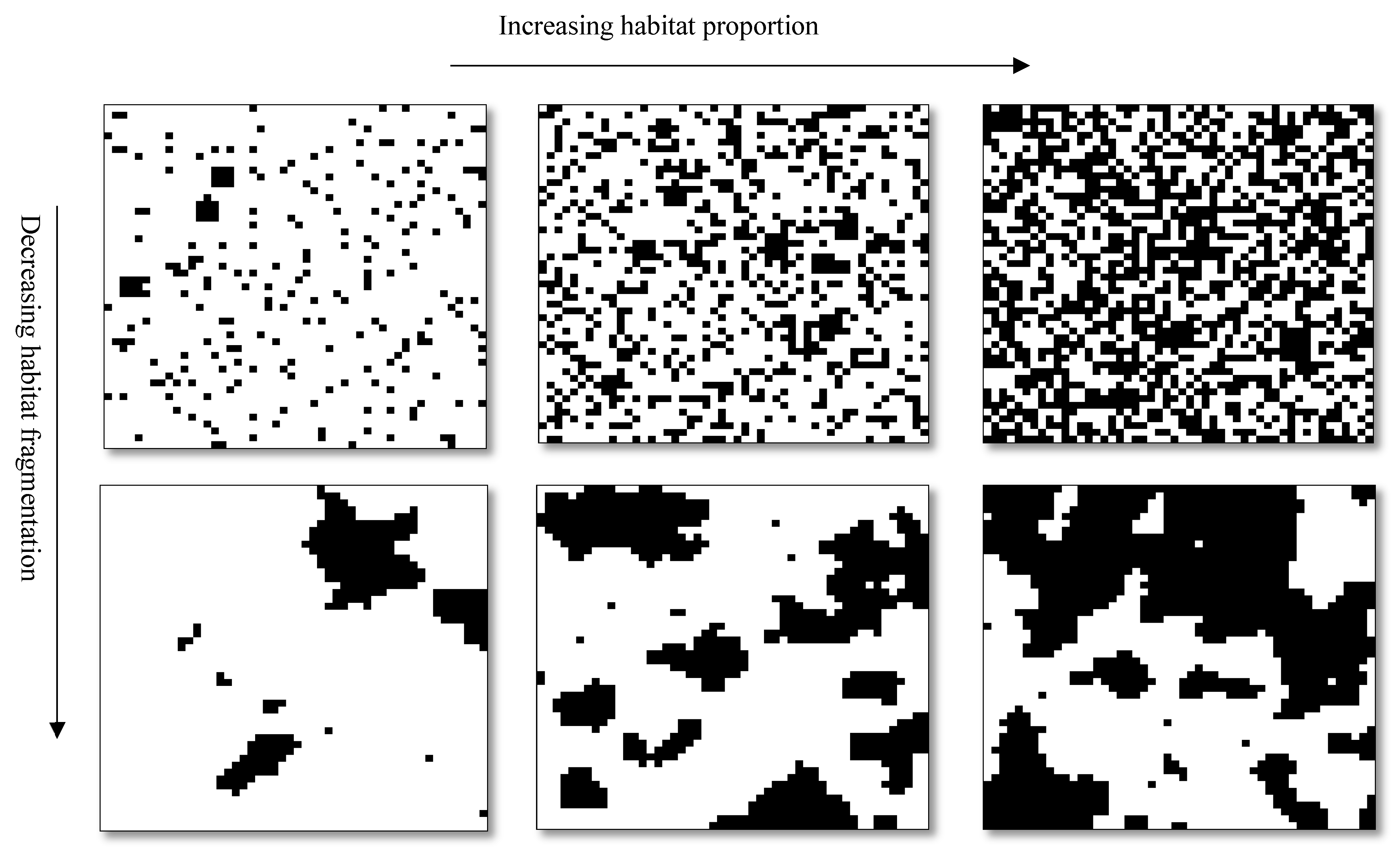
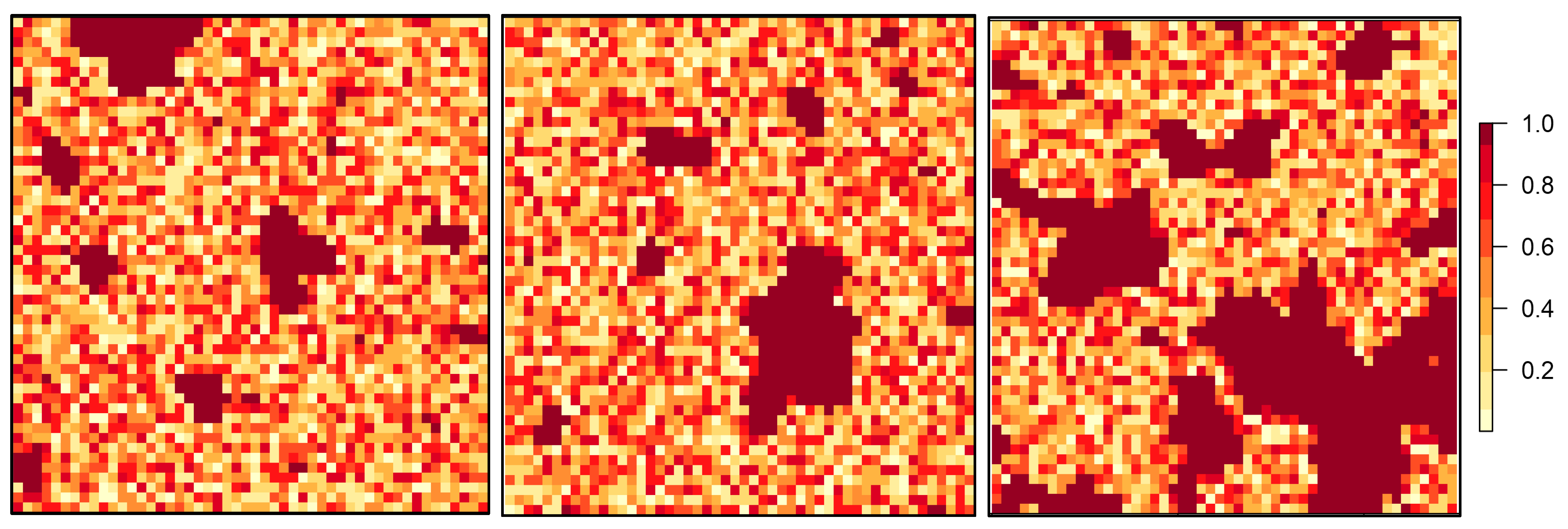
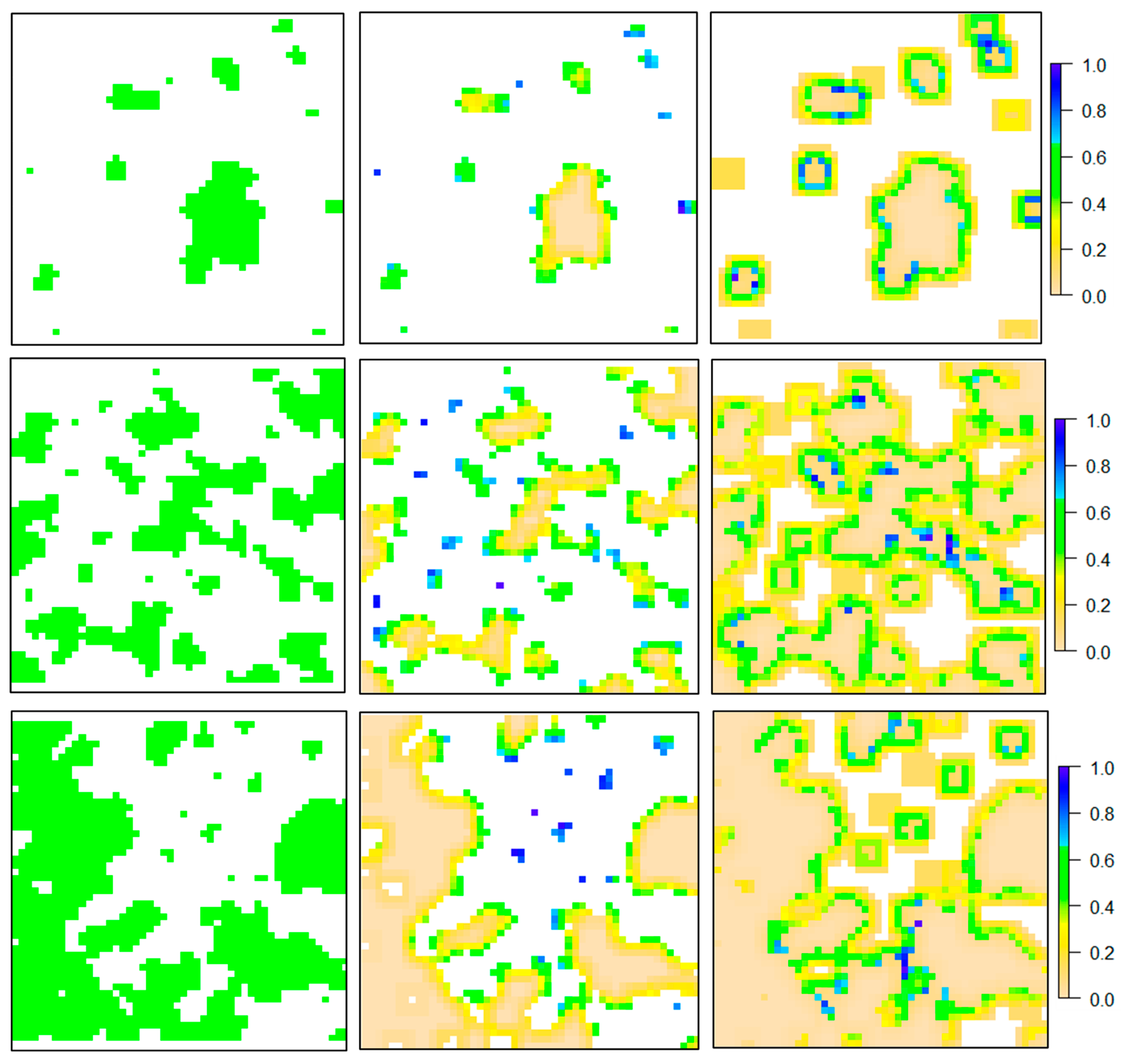

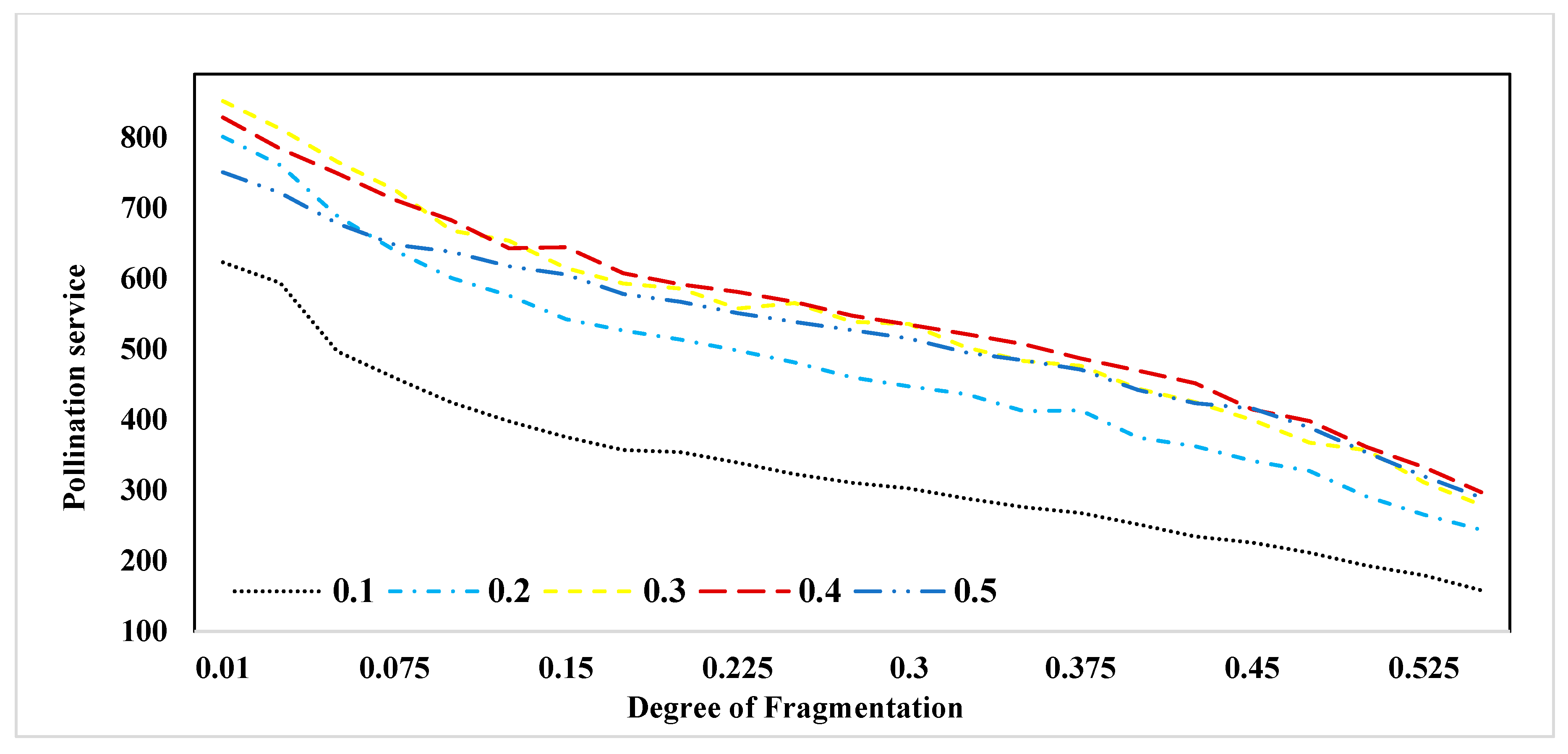
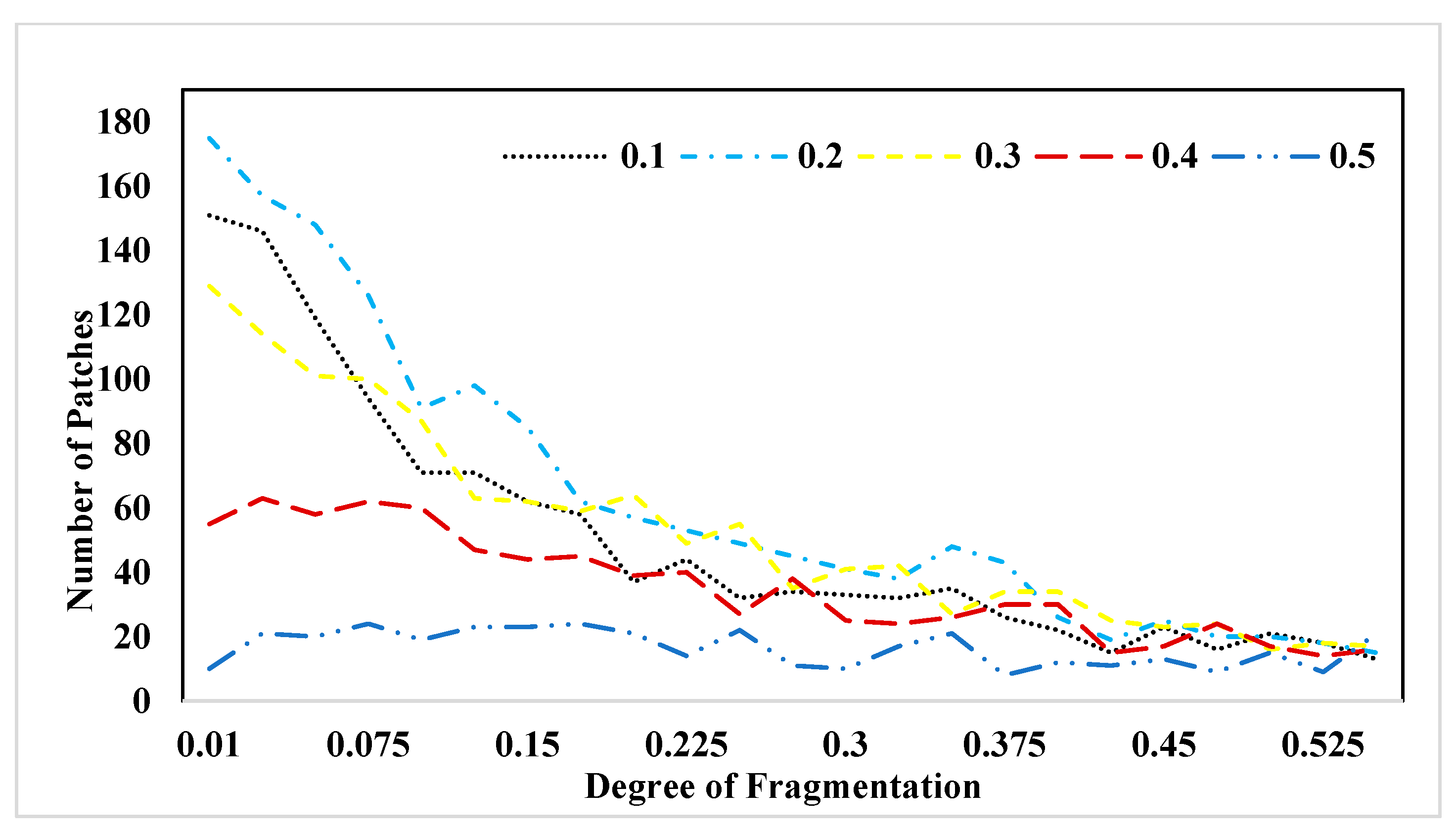
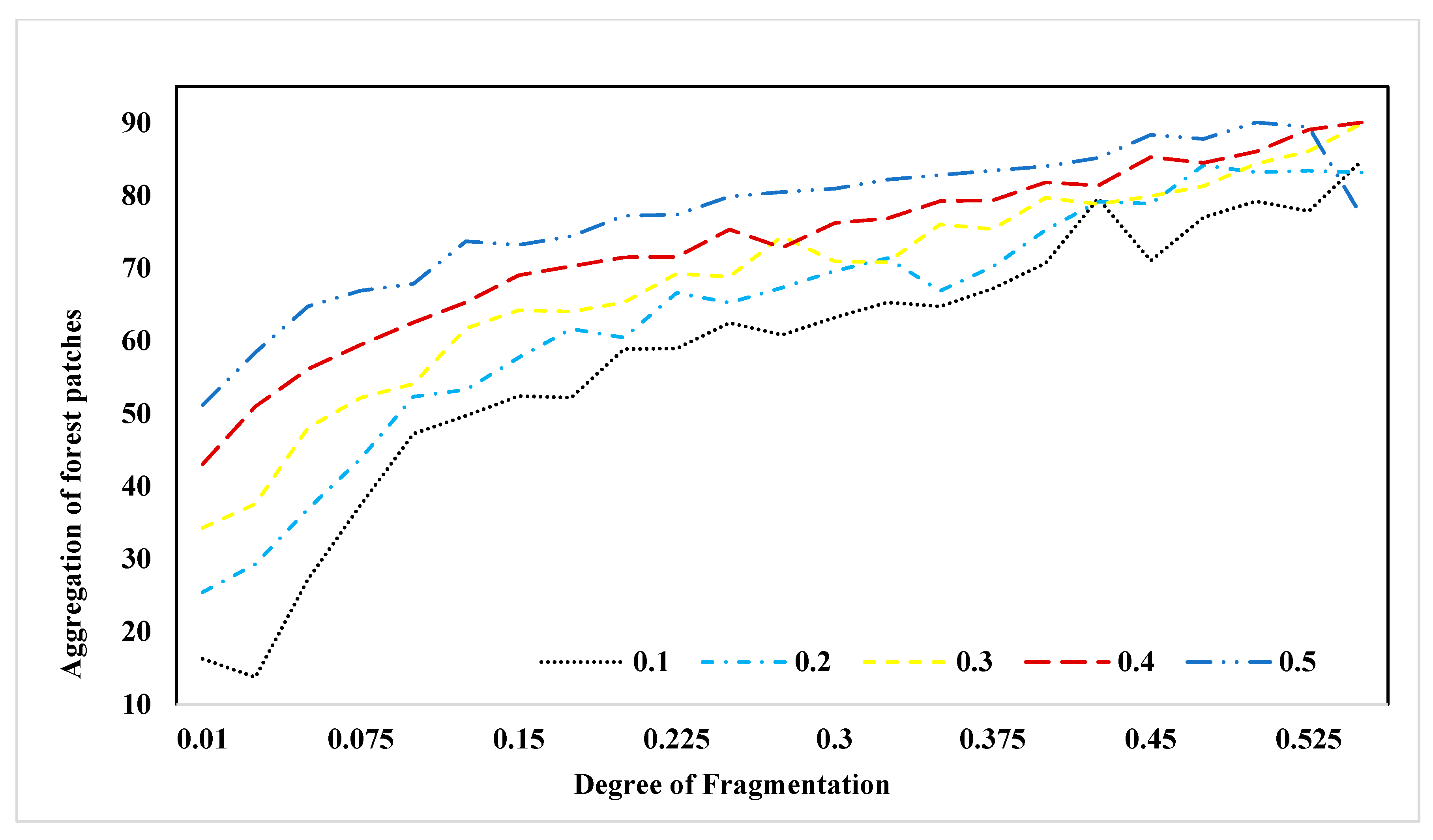
| Forest Proportion | No. Flowers |
|---|---|
| 10% | 225 |
| 20% | 200 |
| 30% | 175 |
| 40% | 150 |
| 50% | 125 |
| Category | Metric | Equation | Range |
|---|---|---|---|
| Area and Edge | |||
| Mean Patch Area (Area-MN) | Area-MN > 0 | ||
| Edge Density (ED) | 0 ≤ ED, no limit | ||
| Aggregation | |||
| Aggregation (AI) | 0 ≤ AI ≥ 100 | ||
| Landscape Division Index (DIVISION) | 0 ≤ DIVISION ≥ 1 | ||
| Number of Patches (NP) | NP ≥ 1 | ||
| Euclidean Nearest-Neighbor Distance (ENN) | ENN > 0 | ||
| NP | PD | LPI | ED | LSI | AREA_MN | ENN_MN | DIVISION | |
|---|---|---|---|---|---|---|---|---|
| PD | 1 | |||||||
| LPI | −0.61 | −0.61 | ||||||
| ED | 0.94 | 0.94 | −0.69 | |||||
| LSI | 0.94 | 0.94 | −0.69 | 1 | ||||
| AREA_MN | −0.76 | −0.76 | 0.60 | −0.87 | −0.87 | |||
| ENN_MN | −0.52 | −0.52 | 0.55 | −0.71 | −0.71 | 0.85 | ||
| DIVISION | 0.63 | 0.63 | −0.97 | 0.74 | 0.74 | −0.69 | −0.66 | |
| AI | −0.94 | −0.94 | 0.70 | −1 | −1 | 0.87 | 0.71 | −0.75 |
| Forest Proportion | Equation | R2 | p-Value |
|---|---|---|---|
| 0.1 | P = 0.2333 + 0.000163 NP | 50% | 0.00 |
| 0.2 | P = 0.2169 + 0.000369 NP | 97.2% | 0.00 |
| 0.3 | P = 0.2133 + 0.000438 NP | 97.5% | 0.00 |
| 0.4 | P = 0.2117 + 0.000501 NP | 93.2% | 0.00 |
| 0.5 | P = 0.2071 + 0.000605 NP | 85.1% | 0.00 |
Disclaimer/Publisher’s Note: The statements, opinions and data contained in all publications are solely those of the individual author(s) and contributor(s) and not of MDPI and/or the editor(s). MDPI and/or the editor(s) disclaim responsibility for any injury to people or property resulting from any ideas, methods, instructions or products referred to in the content. |
© 2024 by the authors. Licensee MDPI, Basel, Switzerland. This article is an open access article distributed under the terms and conditions of the Creative Commons Attribution (CC BY) license (https://creativecommons.org/licenses/by/4.0/).
Share and Cite
Rahimi, E.; Jung, C. Spatial Modeling of Insect Pollination Services in Fragmented Landscapes. Insects 2024, 15, 662. https://doi.org/10.3390/insects15090662
Rahimi E, Jung C. Spatial Modeling of Insect Pollination Services in Fragmented Landscapes. Insects. 2024; 15(9):662. https://doi.org/10.3390/insects15090662
Chicago/Turabian StyleRahimi, Ehsan, and Chuleui Jung. 2024. "Spatial Modeling of Insect Pollination Services in Fragmented Landscapes" Insects 15, no. 9: 662. https://doi.org/10.3390/insects15090662
APA StyleRahimi, E., & Jung, C. (2024). Spatial Modeling of Insect Pollination Services in Fragmented Landscapes. Insects, 15(9), 662. https://doi.org/10.3390/insects15090662







